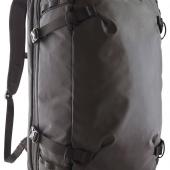Winter Travel
I’ve helped hundreds of people travel to literally every corner of the globe, and my pre-trip visits with some of them continue to amaze me. The eager explorer is always smiling and happy—and why not, he’s going on an adventure he’s dreamed about for years, he’s worked eight months getting straight all the zillion details, and he’s going to spend a quarter of his annual income… but a once-in-a-lifetime trip is worth it. Now he’s come to see me to make sure he stays as well as possible during the adventure—and, oh, by the way, he’s leaving tomorrow!
Rule #1 for people planning to go off on a grand adventure: start planning the health aspects of the trip eight weeks prior to leaving. It may take two weeks to get in to see your doctor, and some of the needed immunizations come in pairs given six weeks apart. See the Trip Planning Schedule on the facing page.
Traveling Outside the U.S.
When assessing health risks, keep in mind one very sobering thought: the most common reason for returning from your adventure in a box is not poisonous snakebites or even malaria. It’s plain old car accidents, falls, or drowning. Ill-trained drivers of poorly maintained vehicles kill more young Americans overseas than all infectious diseases combined. When you travel, do not expect drivers to behave the way you are used to. Learn to say, “More slowly, please” in every native language you will encounter.
While we’re talking accidents, don’t forget STDs. John Walden, a physician supremely experienced in tropical travel, is convinced that warm climates make people horny. (Jungle Travel and Survival, Lyons Press, 2001) You’re out to have an adventure, to have a great time—and sex may be part of the fun. Whether your partner is a native in a foreign country or an Ivy League anthropologist, there’s always a risk of STDs. You know how to take precautions, so keep taking them when you’re traveling.
Blood clots are another ‘accidental’ problem for healthy people of any age who sit for prolonged periods. If the clot dislodges and gets to your lungs, you will be suddenly, deathly ill. Prevention is simple: drink lots of non-caffeinated fluids, and get up and walk the aisle (or do isometric calf muscle exercises) frequently to ‘pump’ the blood back up out of your legs. Unless you’re at substantial risk of head injury, consider taking one aspirin a day to make your blood less likely to clot. If you’ve had DVT previously, see your doctor prior to traveling.
There are three often-overlooked items to consider taking with you. First, tampons may not be readily available outside the U.S., so bring your own. Second, the condoms available in developing countries may not be up to U.S. standards, so again, bring your own. And third, at budget accommodations in developing countries, you may encounter strange and annoying bedfellows—lice, mites, and chiggers—so take a purchased or homemade ‘bed sack’ to sleep in.
Your health insurance might not cover you outside the U.S.; check with the company about this. If you won’t be covered, you can get special traveler’s health insurance from your credit card company, travel agent, Access America, or International SOS. Health costs in developing countries are generally low, but evacuation costs can be extreme. If you’re going to a Level 3 area, consider evacuation insurance. Also, the blood bank may not screen well in Level 2 or 3 countries—if you’re injured, think twice before accepting a transfusion. If you need a transfusion in Africa, get evacuated.
Location-Specific Planning
The first step in effective travel planning is to prepare a detailed itinerary. Where you’re going, your means of transport and housing, and how long you plan to stay—these are all important factors when evaluating risk and formulating prevention strategies. Presenting your pre-trip health providers with a complete, legible itinerary will expedite their work.
The second step is to assess the specific hazards of your destinations. Lawrence Bryson, writing in The Travel Health Clinic Book, divides all foreign locations into one of three risk levels. (See Risk Levels for Foreign Travel on the previous page.) This immensely simplifies planning for basically healthy people. An important note for people who are pregnant, have existing health problems, or take medication on a regular basis: see your regular doctor regardless of destination risk level.
Travelers to Risk Level 1 countries can expect relatively safe water, the absence of exotic infections and creatures, access to competent medical assistance, and cab rides like Space Mountain. Make sure your routine immunizations (like tetanus), are up to date, consider a flu shot prior to departure (in fall or winter), and be confident that a minimal personal medical kit will suffice. Jet lag and sunburn may be your worst health problems. Buon Viaggio!
Travelers to Risk Level 2 countries will need to take precautions with food and drinking water, should consider additional immunizations, may encounter situations where exotic infections are possible, and should have a plan for finding English-speaking healthcare providers. In these countries, your risks will differ greatly if you stay in a four-star hotel in a major tourist destination or in the home of a local rice farmer. Spend a little extra time becoming informed about the health aspects of the local area—check out the CDC website, review guidebooks, or consult a travel advisor. (See Sources of Information & Supplies, previous page.)
Up to 80% of Americans traveling to developing countries get diarrhea, but you can take simple steps to minimize your risk. All tap water should be considered contaminated. Beverages that are bottled or canned, especially if carbonated, are generally safe. (Mas cervesa, por favor!) If restricting yourself to these is not feasible, take iodine tablets or a small submersible heating coil with all the different electrical adapters you’ll need. Assume ice is contaminated, as freezing does not kill disease-causing germs.
Food may have been rinsed in tap water or contaminated by unclean hands. That luscious ripe strawberry may have been fertilized with municipal sewage. Baked goods are generally safe, but watch out for cream fillings. If a food item is served piping hot, it’s probably okay. Rule #2: Boil it, cook it, peel it, or forget it!
Additional immunizations to consider for Level 2 countries are Hepatitis A, Hepatitis B, and Polio. Exotic infections can come from insect bites and through direct exposure to the environment. (Read on for advice on avoiding these.)
Risk Level 3 areas are the most remote, undeveloped, and exciting places on Earth. You should be maximally immunized, prepared to prevent malaria, and equipped to handle illness and injury yourself—competent medical help will be hard to find and possibly far away. You should take all the Level 2 precautions, plus have an influenza immunization, to protect the locals as much as yourself. Vaccination against typhoid is a good idea too, and possibly meningitis and tuberculosis. Yellow fever vaccine may be required. Cholera immunization, however, is considered ineffective.
Many of these destinations also have highly hostile environments, with high altitude, severe weather, or tropical climates, to which you will need to adapt. Your plan should be to ease into vigorous activities.
In addition to water and food hazards, you will also have to contend with insect-borne diseases and parasites. Carefully review the information from the CDC website. If you can’t keep Dengue straight from Schistosomiasis, better have a travel health consultation. (See Local Travel Health Resources on the previous page.)
To avoid mosquito-carried infections, especially malaria, wear lightweight, long-sleeved shirts and pants (no shorts). Apply a 20-30% DEET cream to exposed skin except around eyes and mouth and at the gaps in your clothing. If appropriate to your itinerary, buy and take along permethrin-impregnated mosquito netting or use regular netting soaked in permethrin prior to leaving.
Malaria kills more adults in the world than any other infectious disease. Do not underestimate it. Most travel health experts recommend that you take an anti-malaria medicine starting BEFORE you arrive in the malarial area and continuing for 2-4 weeks AFTER you return. All of these medications are prescription; you and your doctor will decide which is best for you.
The soil and freshwater streams and ponds found in the tropics are sources of unpronounceable parasites. NEVER go barefoot. (or in sandals). Salt water is generally safe, but may be contaminated near cities and at the mouths of rivers. Check with the locals before frolicking in the surf. Soaking in hot-tub-temperature water reduces the pain of most stinging sea creatures.
If you plan ahead, use appropriate medical means to prevent illness, take along a reasonable personal medical kit (see Personal Medical Kit, previous page), and attend to your own safety while traveling, you can have a life-altering adventure without putting your life at risk. Now, if you’d like to pay the way of a physician to accompany you…
Guidelines
Trip Planning Schedule
Prior to leaving:
8 weeksMake appointment with doctor or
travel clinic.
Make appointment for routine dental check up.
7 weeksCheck the CDC website for your destinations.
Apply for passport.
Make out detailed itinerary.
Make out personal medical history.
6 weeksHave doctor/clinic visit:
• bring itinerary & medical history
• discuss personal health history
• discuss hazards of destinations
• prepare prevention & management plans
• obtain med refills and/or written prescriptions
• obtain prescriptions for ‘in case’ meds
• discuss delaying menstruation
Get first set of immunizations.
Have dental checkup.
Get eyeglass prescription.
2 weeksGet second set of immunizations if needed.
Prepare personal medical kit.
8 daysStart malaria medicine if appropriate.
7 daysStart one aspirin a day to prevent DVT if taking a long flight.
Final daysFinish immunizations if needed.
Check CDC & State Dept. websites for travel advisories.
Risk Levels for Foreign Travel*
Risk Level 1
U.S., Canada, Northern Europe, Australia/ New Zealand
Take: Basic personal medical kit.
Risk Level 2 (take food & water precautions; health care available but variable quality)
South Africa, Southern Europe, Eastern Europe, Russia, Israel, Japan, Taiwan, Singapore, Pacific Islands, most of Caribbean, Mexico (large resorts)
Take: Level-1 items PLUS iodine tablets and diarrhea plan.
Risk Level 3 (sanitation and hygiene inadequate; health care questionable or not available; probably need malaria prevention)
The rest of Africa, Mexico, and Asia, South America, Central America, Haiti/Dominica,
Take: Level-1 and level-2 items PLUS emergency medical supplies.
*Source: The Travel Health Clinic Book, Lawrence Bryson, MD, 1996
Sources of Information & Supplies
• U.S. Center for Disease Control & Prevention (CDC), www.cdc.gov/travel, 877-FYI-TRIP
• U.S. State Department Travel Advisories
www.travel.state.gov, 202-647-5225
• Travel Health Online, by Shoreland, Inc.
www.Tripprep.com (private source of information)
• International Association for Medical Assistance to Travelers, www.iamat.org, 716-754-4883 (names of English-speaking doctors where you’re going)
• International SOS, www.intsos.com,
800-542-5911(health insurance, aid & evacuation)
• Access America, www.etravelprotection.com
(travel cancellation and health insurance)
• Medic Alert, 800-432-5378 (familiar bracelets with emergency health info about you)
• Chinook Medical Inc., www.chinookmed.com (travel and medical supplies)
• REI, www.REI.com (travel and recreational gear)
Local Travel Health Resources
• Montana State University
• Student Health Service, 994-2311 (Individual consultations & immunizations for students and spouses) or Travel Education class (open to public),
www.montana.edu/health (select “Travel Services”), Catherine Ebelke, 994-2311
• Gallatin County Health Department,
582-3100 (to schedule individual consultations or immunizations—only source for yellow fever immunization, malaria medicine not available)
• Your Personal Physician
Personal Medical Kit
In your carry-on luggage:
• Regular meds & copies of prescriptions
• Decongestant
• Motion sickness med or wristbands
• Personal health history
• Contact info for personal physician
• Insurance card/policy information
In your suitcase:
Level 1—
• Sunscreen
• Chapstick with sunscreen
• OTC pain reliever
• Aspirin
• Insect repellent
Add for Level 2 & 3—
• Extra eyeglasses/contact lenses
• Iodine tablets or water boiler
• Anti-diarrhea medicine(s)
• Antacid
• Yeast infection treatment
• Antihistamine
• Hydrocortisone cream
• Bandaids
• Antibiotic ointment
• Gauze pads & tape
• 4” elastic bandage
• Condoms (those in developing countries may be sub-standard)
• Tampons (not readily available outside U.S.)
Doctor/Health Specialist visitation
(Travelers who need a visit with their regular doctor or a travel health specialist prior to visiting a Level 2 or Level 3 country)
• Those staying for >6 months
• Those who are or will be pregnant
• Those with pre-existing health problems (especially diabetes, heart, lung, kidney diseases, history of blood clots)
Dean Center, M.D., is a physician at Family Doctors’ Urgent Care in Bozeman.











